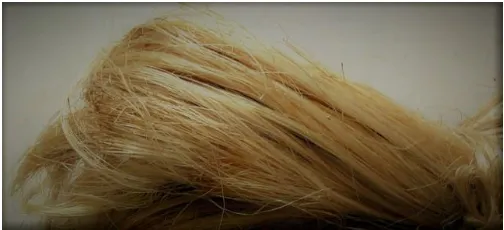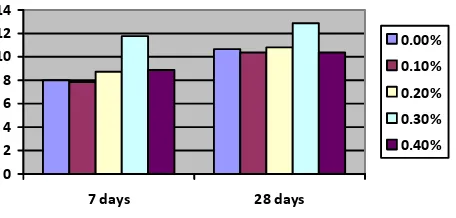© 2018, IRJET | Impact Factor value: 6.171 | ISO 9001:2008 Certified Journal | Page 1846
IMPROVEMENT OF LIGHTWEIGHT CONCRETE BY USING NATURAL
FIBRES
Sukanya Bakkam
1, Sampada Gaikwad
2, Gaurav Udeg
3, Tanmay Ware
4, S.S. Patil
51,2,3,4
Students, Department of Civil Engineering, Gharda Institute of Technology, Lavel, Maharashtra-India
5Professor, Department of Civil Engineering, Gharda Institute of Technology,
Maharashtra- India, 415 708
---***---Abstract
- This project deals with the improvement instrength of lightweight concrete by using natural fibres. Lightweight concrete made a huge impact in concrete field. In this research we are working on lightweight concrete to make it good in strength with respect to non-structural member. Addition of natural fibres with varying percentage (0.1%,0.2%,0.3%,0.4%) have been carried out.
Key Words
:
Lightweight, Natural Fibres, Pumice Stone, Strength, Banana Fibre1. INTRODUCTION
Lightweight concrete is generally selected to reduce the weight of construction. The main specialty of lightweight concrete is low density and thermal conductivity. Lightweight concrete has been successfully used for marine application and in ship building. Lightweight concrete ships where produce in the USA during the 1940 to 1980 war, and their success led to the production of (USS Selma) a war ship. Replacing aggregate with pumice stone reduce density and increases thermal insulation which makes the concrete lightweight. Pumice is a lightweight aggregate of low specific gravity. It is highly porous material with high water absorption percentage. In this we do not use the conventional aggregate and replace it by the pumice stone. Density of pumice stone is 0.25gm/cm3. Pumice is created when superheated, highly pressurize rock is violently ejected from volcano. The unusual foamy configuration of pumice happens because of simultaneously rapid cooling and rapid depressurization. The depressurization create bubble by lowering the solubility of gases that are dissolved in lava, causes the gases to rapidly ex solve. The simultaneously cooling and depressurization freezes the bubble in the matrix. Addition of fiber lowers the permeability of concrete matrix and thus reduce the bleeding of water, it also enhance the toughness property of concrete. Addition of natural fibers leads to enhance engineering properties like compressive strength, split tensile strength, and flexural strength.
2. MATERIALS
As we are familiar with the current situation of availability of material in India, it is quite difficult to access the required amount of raw material which is used for construction work. The ban on any raw material may affect the construction of any site, and to avoid such condition replacement of such aggregates over sand and soil helps to continue the work.
2.1 CEMENT :-
The cement which was used is ordinary Portland cement of 53 grade. The concrete was designed for M25 grade. The OPC 53 grade has a ability to achieve higher strength.
property IS: 8112 -1989
Specimen OPC 53 grade
Normal consistency 35%
Initial setting time 31 min.
Final setting time 580 min
Specific gravity 3.15
Table 1 – properties of cement
2.2 AGGREGATE :-
Aggregates are one of the important material in the concrete which reduce the shrinkage and effect economy
a) Coarse aggregate:
Locally available coarse aggregate having the maximum size of 20mm and fineness modulus of 8.75 is used. The specific gravity of coarse aggregate that was taken is 2.6
Physical properties Values
Specific gravity 2.6
Fineness modulus 8.75
Water absorption 0.5%
Bulk density 1590 kg/m3
Free moisture content 0.2% Aggregate impact value 11.2% Aggregate crushing value 24.12%
Table 2- properties of coarse aggregate
b) Fine aggregate:
© 2018, IRJET | Impact Factor value: 6.171 | ISO 9001:2008 Certified Journal | Page 1847 Physical properties Values
Specific gravity 2.6
Fineness modulus 2.83
Water absorption 0.75%
Bulk density 1654 kg/m3
[image:2.595.37.288.286.415.2]Free moisture content 0.1%
Table 3- properties of fine aggregate
2.3 PUMICE STONE:-
[image:2.595.314.556.295.438.2]Pumice is lightweight aggregate with low specific gravity of 2350 kg/m3. It is highly porous material with high water absorption of 41.66%.
Fig 1- pumice stone
2.4 FIBERS
Banana fibre is one of the most widely used natural fibre and is easily implemented. It has high strength, lightweight, smaller elongation, fire resistance, and strong moisture absorption. It is bio-degradable and has no negative effect on environment and thus can be categorized as ecofriendly fibre.
Fig 2- banana fibres
2.5 WATER
Water is used in the mixing is to be fresh and free from any organic and harmful solution which will leads to deterioration in the properties of mortar, salt water is not to ne used. Potatble water is feet for use mixing water as well as for curing.
3.
EXPERIMENTAL WORK
Replacement of 40% aggregate with pumice stone and 40% sand with pumice powder leads to reduction of weight of concrete and density. The casting was done by varying percentage (0.2%,0.3%,0.3%) of banana fibre as a natural fibre referring the mix design 1:1.17:2.3 with water cement ratio 0.47.
The compressive tests results were taken after 7 days and 28 days of proper curing.
a)
Compressive strengthCompressive strength tests were performed on compressive testing machine using cube samples for varying proportion were tested and average strength values reported in this paper. The loading rate on the cube is 9.83 N/mm2 per min.
Fig 3- compressive strength test
Fig 4- compressive strength test
b)
Flexural Strength [image:2.595.373.496.466.653.2] [image:2.595.35.287.545.660.2]© 2018, IRJET | Impact Factor value: 6.171 | ISO 9001:2008 Certified Journal | Page 1848 Modulus of Rupture=
Fig -5 flexural strength test
A beam of 550*100*100 mm will be casting with suitable proportion and applying center point load method. The value of the modulus of rupture is depends upon the dimension of the beam and the arrangement of the loading.
c)
Split Tensile StrengthSplitting tensile strength test on concrete cylinder is a method to determine the tensile strength of concrete. The concrete is very weak in tension due to its brittle nature and is not expected to resist the direct tension. The concrete develops cracks when subjected to tensile forces. Thus, it is necessary to determine the tensile strength of concrete to determine the load at which the concrete members may crack.
Split tensile test can be calculated by below formula
T = 2P/ π DL
P = applied load
D = diameter of the specimen
L = length of the specimen
Fig 6- split tensile test
4.
RESULTS
The results are taken after 7 and 28 days which are stated below in charted form.
Days Weight of
cube Load Compressive strength
7 5.46 180 8
[image:3.595.310.564.142.389.2]28 5.28 240 10.66
Table 4- result of fibreless concrete
Days Weight of cube (Kg)
Load
(kN) Compressive strength (Mpa)
Average compressive strength (Mpa)
7 days
5.32 180 8
7.85
4.98 190 8.44
5.44 160 7.11
28 days
5.08 220 9.77
10.37
5.6 240 10.66
5.42 240 10.66
Table 5- results for 0.1% fibre
Days Weight of cube (Kg)
Load
(kN) Compressive strength (mpa)
Average compressive strength (Mpa)
7 days
5.58 220 9.77 8.74
5.44 180 8
5.46 190 8.44
28 days
5.32 260 11.55
10.81
5.19 250 11.11
5.24 210 10.66
Table 6- results for 0.2% fibre
Days Weight of cube (Kg)
Load
(kN) Compressive strength (Mpa)
Average compressive strength (Mpa)
7 days
5.60 240 10.66
11.77
5.48 270 12
5.68 280 12.44
28 days
5.58 310 13.77
12.88
5.62 290 12.88
5.28 270 12
© 2018, IRJET | Impact Factor value: 6.171 | ISO 9001:2008 Certified Journal | Page 1849 Days Weight
of cube (Kg)
Load
(kN) Compressive strength (Mpa) Average compressive strength (Mpa) 7 days
5.48 210 9.33
8.88
5.62 180 8
5.59 210 9.33
28 days
5.34 240 10.66
10.37
5.69 220 9.7
5.28 240 10.66
Table 8- results for 0.4% fibre
Sr no Fibre content Compressive strength(Mpa)
7 days 28 days
1 0.0%
2 0.1% 7.85 10.37
3 0.2% 8.74 10.81
4 0.3% 11.77 12.88
[image:4.595.53.281.435.544.2]5 0.4% 8.88 10.37
Table 9- Tabular representation of results
0 2 4 6 8 10 12 14
7 days 28 days
0.00% 0.10% 0.20% 0.30% 0.40%
Graph 1- Graphical presentation of results
From the above figure, it is clear that compressive strength of banana fiber increases from 0.1% to 0.3% and after 0.3% compressive strength is decreases. Hence 0.3% is optimum percentage of fiber mixing in concrete.
The result of split tensile strength for optimum percentage are
Table 10- results for split tensile strength
The result of flexural strength for optimum percentage are
5.
CONCLUSIONS
[1] Studying above results, it is clear that 0.3% is the optimum percentage at which we get optimum results
[2] From the above investigation, it is clear that simultaneous replacement of aggregate and also sand is feasible in concrete as it gives satisfactory results for non structural member.
[3] As sand is also replaced with the pumice powder, flexural and split tensile strength is affected much which cannot be improved even after addition of banana fibres.
REFERENCES
[1] A. Suba Lakshmi , S. Karthick et-al.(2017),”Experimental investigation on light weight concrete using pumice aggregate”, international journal of innovative and emerging research in engineering ,ISSN :2394-3343,VOLUME 4,ISSUE 3, 2017
[2] Raphael Chacko, S. Hema et-al,(2016),”Experimental study on coconut fibre and banana fibre reinforced concrete”, international journal of earth sands and engineering ISSN 0974-5904, Volume 09, No 3
[3] 2. G. Venkatesan, R. Raghupati , et-al. (2016), “Experimental study on high performance concrete using natural fibre (coir fibre)”, Middle East Journal of Scientific Research, 24(Recent innovation in engineering, technology, management and application):148151,2016
[4] 3. Ashwairya Gopinath, Amla D. et-al (2017), “fibre reinforced pervious concrete using banana fibre”, International Journal of Engineering and Management Research, Volume 7, Page No. 127-132 4. Rajeshwari S. Dr. Sunilaa George et-al (2015), “Experimental study of lightweight concrete by partial replacement of coarse aggregate using pumice aggregate”, International Journal of Scientific Engineering and Research, ISSL 2347-3878, Impact Factor (2015): 3.791
[5] 5. Abhijit R. Agrawal, Sanket S. Dhase et-al (2014), “coconut fibre in concrete to enhance its strength and making lightweight concrete”, International Journal of Engineering Research and Development, Volume 9, Issue 8, PP. 64-67
Days Weight of
cylinder (Kg) Load (kN) Tensile strength(Mpa)
7 9.08 120 1.13
28 9.21 160 1.50
Days Weight of
beam (Kg) Load (kN) Flexural strength(Mpa)
7 9.35 12.94 2.354
© 2018, IRJET | Impact Factor value: 6.171 | ISO 9001:2008 Certified Journal | Page 1850 [6] 6. S. Sabrinathan, Jibin et-al (2017), “An experimental
investigation on mechanical behaviour of concrete by using banana fibres”, SSRG International Journal of Civil Engineering-(ICET 2017) – special issue- March 2017
[7] Mix design 10262:2009
[8] Indian Code IS 456:2007


